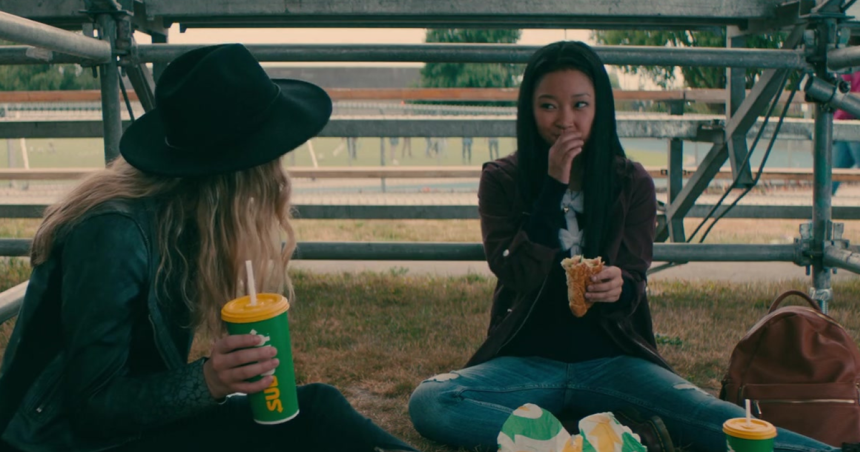In a world where ads can be superimposed onto Hollywood content, some companies are opting to stick to the old-fashioned route.
Virtual product placements, where ads are inserted into shows, movies, and social media content after filming, are a hot topic of discussion as AI companies emerge with options to add custom products and signage to everything from TikTok and YouTube videos to podcasts.
But even as virtual placements start to creep into Hollywood productions and make it even easier to put ads just about everywhere, some executives in marketing and production told us they’re still banking on the sometimes higher-effort option of manual product integrations.
Back to basics
Proponents of old-school product placements include Matt Kaplan, CEO of the production company Ace Entertainment, which has produced films like Netflix’s To All the Boys I’ve Loved Before, and Harley Block, CEO and co-founder of Gen Z consultancy IF7. Together, the two work on what Block calls “deep integrations,” which integrate products and brands into the story rather than just placing them in certain shots.
“It starts with the creative first,” Kaplan said. “We work on the scripts, we build out [the characters’] backstory…then we’re going out to a couple of brands that could fit the needs of the film.”
In To All the Boys I’ve Loved Before, one character loves the sandwich chain Subway, while another is a fan of the Japanese yogurt brand Yakult, which saw a spike in sales after the movie’s release in 2018. In Ace’s 2023 movie Love at First Sight, disinfecting wipes are featured to highlight a character’s cleanliness habits, Kaplan said.
Love at First Sight, also released on Netflix, has been watched by 50 million people, Kaplan said, and held the No. 1 movie spot on Netflix for two weeks. (Netflix doesn’t publicly release viewership figures, but previously said the film had 36.8 million views in its first three weeks on the service.)
That high performance at the outset generated chatter on social media and helped benefit brand partners by integrating them in the cultural moment, Kaplan said. After the initial hype dies down, there’s also the possibility that people may continue to watch—or rewatch—these movies for years to come, he added.
“I think that’s such a better value than running a commercial,” he said.
There are some limitations to manual integrations, given that, even if every character were to name-drop a brand, overt placements can generate backlash—something that came up earlier this year with the Mean Girls musical.
Get marketing news you’ll actually want to read
Marketing Brew informs marketing pros of the latest on brand strategy, social media, and ad tech via our weekday newsletter, virtual events, marketing conferences, and digital guides.
Ace tends to limit integrations to no more than two or three brands per movie, even if inbound interest is high, which is designed to prevent placements from feeling “in your face and cringy,” Kaplan said.
“We’re willing to do what’s best for the film, and if there’s only going to be two scenes that fit that opportunity, that’s what it is,” Kaplan said.
Block said that being intentional around insertions is also an effort to be respectful to audiences. “Consumers are smart. They’re very, very savvy,” he said. “They know when [product placement is] happening, and if it’s done poorly, you’re gonna pay for it.”
The rest is still unwritten
There are some instances where post-production placements can come in handy.
In the 2023 romcom Anyone But You, Erin Schmidt, chief product placement officer at BENlabs, which handles product placement and influencer licensing, said the agency was able to get LinkedIn featured in a scene after shooting had wrapped—something that would not have been possible had it been a script integration.
“That’s where you can even the playing field a little bit and make sure that you’re not missing out on opportunities,” Schmidt said.
Still, much of BENlabs’s work centers around manual storyline integrations, Schmidt said. One reason? The juice isn’t always worth the squeeze.
“For a digital insertion, the CPM is somewhere between $50–$60, whereas for storyline-driven integrations, our average is around $25,” she said, adding that unaided recall tends to be higher on storyline integrations.
As AI is used more in these kinds of placements, Schmidt said she wonders about the ability for creatives to realize some of the financial benefits of the insertions directly, not just distributors. Could a soda inserted into an actor’s hand in postproduction, for instance, make them something of an unwitting brand ambassador?
Schmidt also hopes the industry doesn’t “overdo” it on insertions just because it could become easier to do. “If all of a sudden we’re super superimposing brands all over our content, that makes me really scared as a lover and viewer of content,” she said.
Schmidt told us she’s optimistic that AI can help collect audience data to inform product-placement decisions, but cautioned that it may not be the best option for all product placements moving forward.
“My argument is always, ‘Don’t put all your eggs into one basket,’” she said.
Read the full article here










